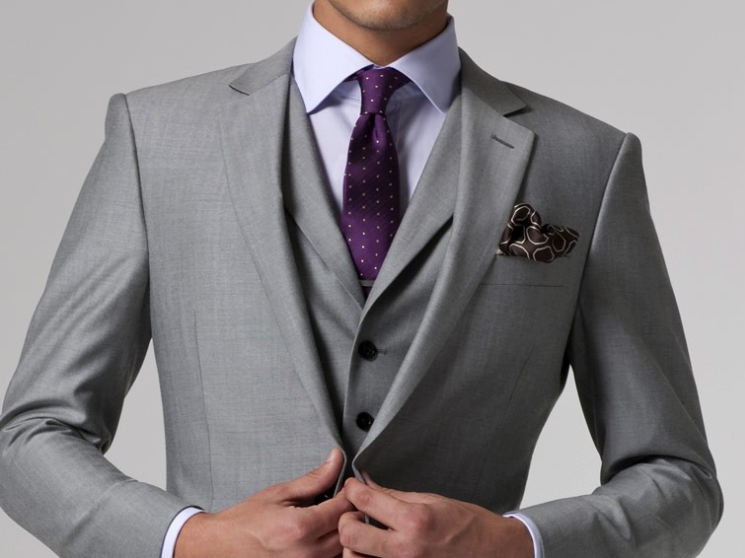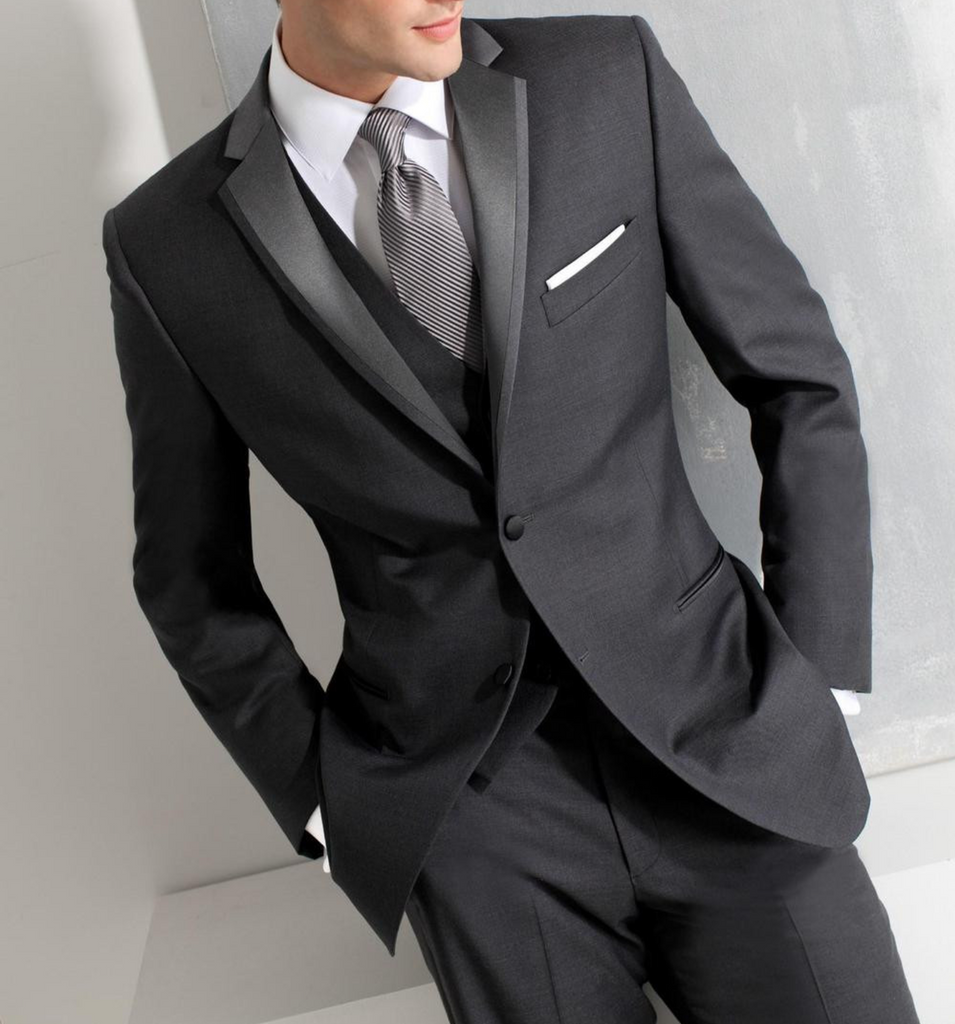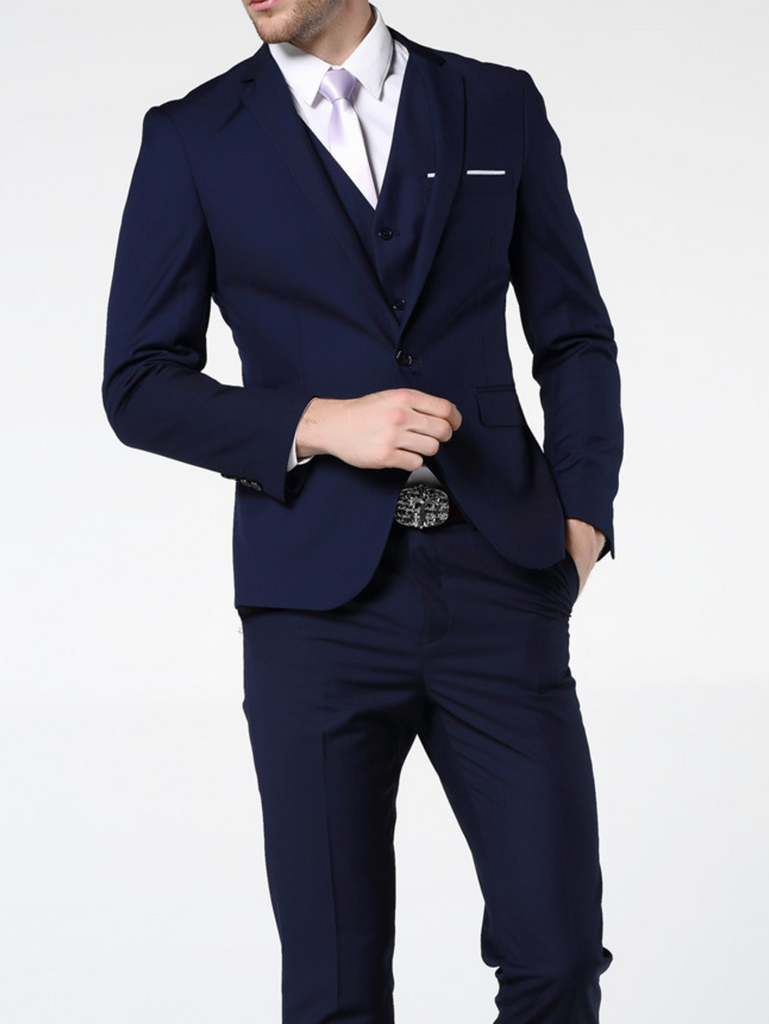Suit Up: a Guide to Buying a Suit for Any Occasion

Most guys don't realize there isn't a suit in the closet until an upcoming event--maybe a wedding or a new job--suddenly reminds you that you need one. Or, if you do have one, it might be twenty years old and out of style. Either way, it's time to go shopping. Unfortunately, buying a suit can seem very complicated; wrapping your mind around details like sizing, style, material, and quality can quickly get overwhelming. This guide will help you walk into the store with confidence and ensure that you're going to leave looking great.

Shopping advice
Before you can start shopping for a suit, you'll need to decide where you're going to shop. It isn't especially difficult to find a store selling suits, from discount chains to department stores to high-end boutiques. Remember, you get what you pay for--and that applies to both the product and the service. While they might be fine for casual clothes, stay away from lower-end retailers when suit shopping. A quality suit is an important part of your wardrobe and you won't look your best in a cheap one. Many popular department stores don't train their employees well enough to give you reliable advice, leaving you to your own devices. For the best experience, turn to a respected retailer or a specialty shop. At Nordstrom, for example, you'll find a variety of labels, knowledgeable salespeople and skilled tailors. It's also worth checking out the shops of trustworthy designers like Brooks Brothers, Hugo Boss, and Ralph Lauren. If your budget allows, visit high-end, high-fashion makers like Zegna, Burberry, Brioni, and Armani, or even explore made-to-measure options.
One more tip: wear a dress shirt and shoes when suit shopping. It's much easier to judge the fit when you're dressed suitably, rather than in a bulky sweater and sneakers.

Choosing a style
Navy, with pinstripes and peak lapels? Double breasted in a grey plaid? Classic black? You have a lot of choices to make. Ultimately, while your taste is a factor, you should pick a style that's appropriate for your suit-wearing needs. If you only have one suit, pick a single breasted one in solid navy or charcoal. That will be the most versatile choice and can be worn to weddings, job interviews, and virtually any other occasion. While black suits used to be the norm, these days they're considered too formal for everyday wear, though if you're attending an above-average number of galas or funerals a black suit would work. Browns and tans are less common, most often worn in the summer and fall and generally seen as more casual.
Patterned suits, like stripes, plaids, or checks, add a little flair, but they can also be too flashy in a conservative business setting. Keep in mind that bold patterns add an extra challenge to coordinating the shirt and tie. There is also a greater risk of the particular pattern falling out of fashion; pinstripes, for example, are considered dated now. A solid suit is timeless.
Construction and quality
Not all suits are created equal. Material and construction vary greatly, leading to huge differences in price, fit, and durability. Most inexpensive suits are going to be made of polyester or blends. Synthetic fibers like polyester are cheap to produce, but they also look and feel cheap. Polyester doesn't breathe well, meaning the suit will trap body heat and odor. A polyester suit might seem like a bargain, but it won't last nearly as long as a well made wool suit, especially if you make the mistake of dry cleaning it too often. Look for a wool suit instead. You might also see wool blended with other natural fibers like silk, cashmere, or mohair, which give the fabrics different properties.
The internal construction isn't always easy to judge, but a decent salesperson will be able to explain how each suit is made. There are three main categories: fully canvassed, half canvassed, and fused. Full canvas is rare and generally only seen in top-of-the-line suits. The term refers to the free-floating layer of canvas between the outer fabric and the interior lining on the suit's front panels. The stiff canvas gives the suit its shape and over time will conform to the wearer's body, enhancing the fit. A half canvassed suit is more common and almost as good. The canvas starts at the shoulders and usually stops around the top button; you can feel the end of the canvas by pinching the suit and running it between your fingers. A fused suit uses a layer of fabric glued to the outer fabric to create stiffness intended to imitate canvas. Fused suits are cheaper and easier to make, but the glue has a tendency to deteriorate and make the liner separate from the outer fabric, causing bubbles to appear and ruining the suit.

Sizing and fit
Getting the right fit is critical to looking like a dapper gentleman rather than a teenager in his dad's hand-me-down suit. Suits are sized based on chest measurements, usually in even numbers. Sleeves come in three standard lengths: short, regular, and long. A man with a 42 inch chest and 34 inch sleeves would wear a 42R suit (though variations in brands can sometimes require moving up or down a size). Trousers are typically sized six inches smaller than the chest, meaning a 42R suit will have pants with a 34 inch waist. The trousers will normally come with an unfinished hem and be tailored to the necessary length. Sometimes the jacket and pants are sold separately, which can be convenient for men whose chest and waist aren't within the standard six inch drop. If your proportions are unusual it will be hard to find the right size off the rack; a 36L or 48S, for example, are very uncommon sizes in most stores. Similarly, anything larger than a 50R will often require a visit to a big and tall store. It's worth considering a made-to-measure suit that will fit correctly instead of trying to make the wrong size work anyway.
Different suits in the same size will fit differently, depending on the way they're cut. A slim fit suit will be flattering on men with a thinner body type, while large guys will want to look for a suit with a more generous cut. Most designers offer several lines, providing a variety of cuts to try.
There are a few key things to look for when evaluating a fit. First and foremost, the shoulders need to fit properly. The edge of the shoulder pads should line up with the outside of your shoulder. Too tight and it will look like you're bursting out of the jacket. Too big looks sloppy. The shoulders can't be tailored, so it's critical that they're sized correctly from the start. Almost everything else can be altered, so you don't necessarily need to demand perfection off the rack, but try to get close. The sleeves should end at your wrist bone, allowing your shirt to stick out about half an inch. Standing with your arms to your side, the jacket's length should reach the middle of your palm. The jacket, when buttoned, shouldn't be tight in the chest and the lapels must lay flat. It can't be too tight to button comfortably, nor can it be too loose and boxy. The back of the jacket needs to lie smoothly between the shoulders without puckering or stretching. A competent salesperson will be able to point out where the fit isn't working and suggest whether alterations can solve the problem.

Alterations
It's pretty rare for a suit to fit perfectly off the rack, so a visit to the tailor is in order. At the very least you'll need to hem the trousers to the right length and possibly adjust the waist; tailors can take in or let out most pants by a maximum of about two inches. The width of the leg can also be tapered for a slimmer fit. The jacket can be taken in at the sides for a slimmer fit, but it's harder to let it out because there isn't usually much excess fabric in the seams. Sleeves can be shortened, which might require moving the buttons. They can also be lengthened slightly, depending on the fabric allowance. These are all very common alterations, and while more extensive tailoring can be performed, it's probably a sign that the suit simply isn't a very good fit. Tailors aren't magicians. The more that has to be done, the greater the expense and the risk that it won't turn out to be a suit that you're happy with.
Please remember that tailoring takes time. Too many guys buy a suit on Friday intending to wear it to a wedding on Saturday. This doesn't leave enough time to finish the alterations that will make the suit--and you--look good. Try to allow at least two to three weeks if possible, which also gives the tailor enough time to readjust anything that might not have met your expectations the first time around.
This might seem like a lot of information to process, but know that buying a suit doesn't have to be daunting. Many details, like what type of lapel to choose, or whether to go with one or two vents, just aren't worth agonizing over and come down to your own fashion sense. Look for a simple wool suit that fits well and you'll be good for almost any situation. Bring a stylish friend when you shop and don't hesitate to try another store if the salesperson seems unhelpful or inexperienced. Quite often, a guy will buy a suit expecting to wear it once a year, but once he realizes how good he looks will find excuses to pull it out of the closet. Go get yourself a suit that you'll look forward to wearing.
More Readings: